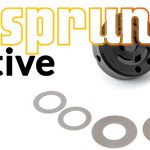Elevensix vs DHX2 vs CCDB CS
WE HAVE A DEMO ELEVENSIX IN STOCK AS OF 3/8/17
As trail and enduro bikes have gotten lighter, faster, and more capable through rough and rowdy terrain, the new-school version of an old technology—the coil shock—is making a healthy comeback. And unless you’ve had your head in the ground for the last year, chances are you’ve noticed the uptick in coil-sprung rear triangles everywhere from Pinkbike to bikeparks to your backyard trails.
Because your head hasn’t been underground—it’s been busy piloting your bike through rock gardens—you’ve heard all about how coil shocks offer unmatched bump sensitivity, heat-shedding, and the prospect of less maintenance. Frame manufacturers such as Evil, Niner, Guerilla Gravity, and more have taken note, too, going as far as to offer boutique Push Industries’ flagship Elevinsix coil shock as original equipment. Not to be outdone, Cane Creek and Fox have also released trail-oriented coil options, the Double Barrel CS Coil and DHX2 respectively, which are finding their way onto premium build kits across the industry. Hell, even Specialized has a coil build option, thanks to a partnership with euro suspension experts Ohlins.
While added weight, often hefty price tags, and some frame compatibility issues mean that the coil comeback is not for everyone, it looks like this trend is here to stay. So now that there are some great coil options on the market, how do you choose the shock that’s right for you?
Over the last 3 months we put the Push Elevensix, Cane Creek Double Barrel Coil CS, and Fox DHX2 through the wringer—from the Colorado Front Range and high country to the Utah and Arizona desert—to see which shock performed the best.
Breakdown
*Tested on a 2017 Yeti Sb6, 150lb rider, playful/jumping riding style
For the test, I was able to set up all three shocks for the same sag point, 13mm, which equates to just over 20.5% sag and ran 400lb springs across the board. Notably this sag is 4% – 5% less than the sag I run on air shocks (Float x2, Float X)
| Pros | Cons | |
| Elevensix ($1,200 w/ spring) |
● Seamless transition between compression and rebound ● Tunable “climb” switch ● Great out-of-the-box tune with frame, rider weight, and terrain considerations. ● Made in the USA ● Tool-free adjustments ● Predictably |
● Heaviest of the three (~60 grams heavier) ● No high-speed rebound adjustment ● Proprietary coils ● Smaller range of adjustability, inversely finer adjustment ● Frame-specific tunes makes swapping between bikes harder (Push does provide re-tunes during service |
| DHX2 2-pos ($759 w/ SLS spring) |
● High- and low-speed rebound ● Widest adjustment range ● Competitive price point ●25-lb springs increments |
● Lacking bottom out control ● Slight top-out ● Non-adjustable climb switch ● Each click provides a more noticeable change (less finite) |
| DB Coil CS ($795 w/ Valt spring) |
● Intuitive climb switch ● Supportive feel ● High- and low-speed rebound adjustment |
● Slight top-out ● Lacking bottom out control ● Cumbersome controls and no ‘clicks’ on high-speed circuit ● Lacking ultra small-bump compliance (especially for <120lb riders) |
Tech Talk
Ease of Transition / Control
Winner: Elevensix
In all reservoir shocks, oil flows in one direction during compression and the opposite direction during rebound. There is inertia associated with this oil flow, and the change in direction can induce lag. A noticeable attribute of the Elevensix is that it achieves the transition more flawlessly than other shocks. This translated to a predictable, controlled, planted feel through rough terrain.
Small Bump Compliance
Winner: DHX2
Fox’s DHX2 has the ability to be most compliant and required the least amount of force to move the damper assembly (when not using any compression damping). But before writing this is off as the end-all-be-all we need to consider why we are using coils in the first place; the sticition related to aircans. Less stiction means that 98% of riders will have to add some low speed compression damping to counteract rider input into the shock (pedal bob, etc.). So, the very open end of the compression spectrum will only be used for the lightest weight rider.
Out of all the shocks I tested, I ran the DB Coil CS closest to open (least compression damping). With a 400lb spring I found myself running only 1 full turn of high speed compression (from open) and 5 clicks of low speed to find the appropriate ratio of small bump compliance and support. The DHX2 had the most compliance; 12 clicks of HSC and 13 clicks of LSC. The Elevensix felt the best right in the middle of their spectrum which is what was recommend from Push.
Adjustability Range
Winner: DHX2 / Elevensix
Overall, the range of adjustment on the Elevensix is not very wide. The reason for this is that the shock is specifically tuned for your bike and weight from the factory, therefore there shouldn’t be the need to go to any extremes with the external adjustments. The outer limits of the Elevensix stay within a “usable” range, thus making staying in the sweet spot a lot easier. For >90% of riders, the range of adjustment on the Elevensix is plenty. The only time I do see a need for more control is for fine tuning rebound damping. In my case, I felt I wanted more pop (less high-speed rebound damping), while maintaining slower low-speed rebound damping. The Elevensix does not have independent rebound controls like the DHX2 and DB Coil CS dampers.
The range on the DHX2 is massive (the biggest on the market); this allows for the shock to be transferable to other frames and rider weights but means the sweet spot is harder to find and easier to be outside of. The DB Coil CS range is slightly more within that usable range opposed to the DHX2. While I find the range appropriate for 95% of riding styles, Cane Creek’s shock does lack extreme small bump compliance, but for most riders this will not make a difference in a coil application.
Climb Switch
Winner: DB Coil CS
The Double Barrel’s climb switch is second to none. Cane Creek’s glue-like circuitry restricts both compression AND rebound circuits while every other switch on the market just shuts down compression. Having the added rebound oil flow manipulation allows you to press into technical features without getting bounced off and losing rear tire traction. If you are technical climber, The DB Coil CS is the best option.
The Elevensix came a close second in the uphill department thanks to its tunable switch—a setup that Push will also pre-specified upon ordering the shock. Want a traditional climb and descend setup? No problem. Want a trail and jump mode? Sure thing! You can even specify a smooth trail and technical trail mode. If you want a do-it-all switch that allows you to change the amount of force it takes to break through the ‘climb’ mode, you will love the Elevensix.
Do you mainly pedal up smooth roads or trails to bomb down technical singletrack? The DHX2 gets it done effectively with traditional climb and descend modes—the former being quite firm and efficient on smooth surfaces.
Bottom-Out
Winner: ElevenSix
Push has had a slightly different approach with their bottom out bumpers for the last eight of so years. Push’s bumpers are twice as long as Fox’s and act to add a more progressive and bottomless feel. We have been told that Push is using upwards of 4 different bottom out bumpers dependent on frame design and rider weight. Though I did not notice a harsh bottom with the DHX2 or DB Coil CS, they did not feel quite as bottomless.
Top-Out
Winner: Elevensix
The Elevensix uses a damper design that routes oil through the internals of the main shaft. This allows the damper seal-head to shut down a port towards top-out and brings the damper to a more linear stop before full extension, alleviating top out feel. With the DHX2 and DB Coil CS, there is an inherent top-out sensation that is associated with twin tube dampers. These dampers have no way to hydraulically control this issue. Additionally, the lack of a negative air-spring, like those found in air shocks, means there is nothing forcing the piston inwards and thus the shock hits an abrupt stop at full extension. Fox and Cane Creek combat the issue with rubber top-out bumpers, but it does not alleviate the experience in its entirety. The best way I can describe the sensation is like having a slightly loose shock bushing, but it is only really noticeable when skimming high-speed, medium-sized hits.
*Tested on 2017 Transition Patrol C, 190lb rider plow/charge riding style
“The eleven six tuning is pretty damn close out of the box, but if you can rid your brain of the slight top-out and can spend time tweaking, you can get the DHX2 and CCDB pretty close to the Elevensix” Said Luby, the owner and founder of Dirtlabs. “Is the Elevensix, the easiest to setup, best performer, well… if you have the pocket to pay for it -yes.”
The Bottom Line
The Elevensix offers superior out-of-the-box performance and the tunable climb switch allows for external tuning for the fire-road climb or technical ascent. Push has spent the time in R&D to dial in both frame leverage rates as well as rider preferences allowing for great performance right away.
The DB Coil CS is a technical-climber’s dream but also doesn’t fall short on downhill performance. The CCDBCS will reward those willing to spend a little time to tinker for the right tune.
The DHX2 carries with it all of the name-recognition, tunable performance, and resale value of a Fox Racing component. Tech-savvy riders that know what they want and don’t mind a firmer climb switch will absolutely love this shock.
Testing these shocks on a linear bike like the Yeti SB6c paired with the linear nature of the coil means you have to run a stiffer spring in order to avoid bottoming out too often. The added ride height (less sag, steeper head-tube) made me stay more active on the bike, pushing through terrain features to stay in the sweet spot of the geometry. The downside of the added ride height is when experiencing a square hit while not loading the rear end of the bike (i.e. taking a poor line through lot of chunk). The square edge, unexpected, hits were a bit harsher than air shocks, mostly due to the sag point.
After nearly two months of tweaks and revisiting each shock again and again, I still do not have a clear winner. Each shock has its own set of advantages. I like the planted, controlled, predictable nature of the Elevensix through repetitive hits and big rock features, but in more varied terrain with lots of high speed ‘jump-over’ opportunities, I leaned towards the twin tube setup of the DB Coil CS and DHX2. When it came to the climb switch, Cane Creek’s offering was by far my favorite. For now, I have decided to keep the CCDBCS as my every day shock for its climbing prowess and tuning ability.
Curious about serviceability? We will be servicing all of the shocks mentioned above for the 2018 riding season





